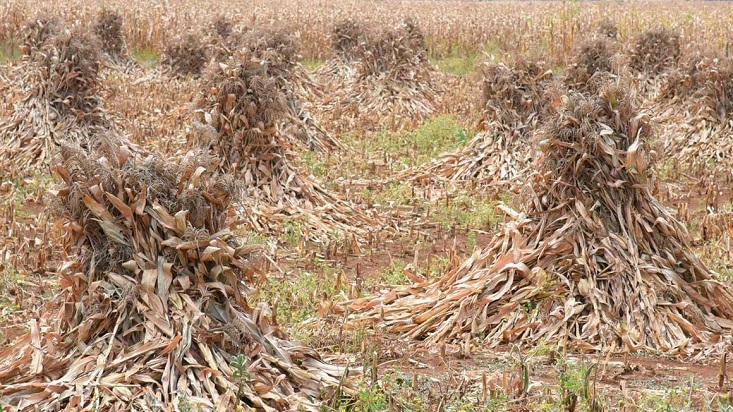The high cost of maize at the peak of harvesting comes as a boom to farmers. PHOTO | JARED NYATAYA | NMG
Joseph Wanjala is a happy farmer. For the first time, he is earning a record KSh4,500 (UShs138,273) for a bag of maize at the farm in November.
The high cost of the staple at the peak of harvesting comes as a boom to farmers but portends difficult times for consumers who have to contend with the high cost of flour.
The high prices of the staple come at a time when Kenya faces one of the worst famines with more than half of the counties now crossing to the acute drought stage and 5.1 million people in need of food relief.
“For me, this is one of the best years, in my 20 years of farming, the prices of maize have never hit this high,” said Mr Wanjala.
Whereas the selling price is impressive, the total production in the ongoing crop season is expected to drop at least three million to 34 million bags.
This implies that the available stocks expected this year will last for nine months and Kenya will have to rely on cross-border imports to meet the deficit.
The decline will add pressure on available food and is likely to worsen the situation given that the traditional source markets for Kenya-Uganda and Tanzania have found alternative markets for their crop in South Sudan and the United Arab Emirates where they fetch a good price.
Timothy Njagi, a fellow at the Egerton-based Tegemeo Institute of Policy and Research, says prices at this time of the year are supposed to be at least Sh2,000 on average.
“The prices that we are witnessing now are the cost that we would normally witness in April, which is the peak season for maize price in Kenya,” said Dr Njagi.
Mr Njagi said the rising cost of maize coupled with other food commodities would see most households spend more on food hence defaulting on other items such as rent.
Kenya’s food shortages have been attributed to overreliance on rain-fed agriculture, inefficiencies along the value chain and the high cost of inputs.
The weatherman has already forecast failed short rains for October-November-December, pointing to another round of failed crops in the next cycle of production.
Short rain crops normally play a key role in supplementing the main harvest, which ensures that maize is available throughout the year.
Kenya has been a food deficit country over the years and it has been relying on cross-border imports to meet the growing demand for the ballooning population with the monthly consumption having shot up from three million bags previously to four million currently.
Dr Njagi says the cyclic hunger in Kenya cannot be contained if the policymakers fail to deal with the shocks of climate change, adopt improved technology and invest in extension services.
“As a country, we have been unable to handle shocks emerging from climatic conditions such as drought because we are mainly relying on rains for our farming activities,” he said.
Dr Njagi said there has been little investment in irrigation with only 20 per cent of the total irrigable land having been put under the water cover.
This is although only 18 per cent of the total land in Kenya is suitable (arable) for farming.
He says productivity has also stagnated owing to the high cost of farming inputs and depleted soil fertility.
This year, according to Inter-Governmental Authority on Development (IGAD), the long rains failed for the fourth consecutive time and it is projected that there will be a fifth-time failure in the remainder of the year.
“By May of this year, our worst fears were confirmed as we recorded below average precipitation and the onset of the longest dry spell in 40 years and the fourth drought in 10 years that has severely affected the arid and semi-arid lands of Kenya,” said IGAD.
“The forecast for the remaining part of the year is no better, raising the possibility that we may witness a record-breaking fifth consecutive season of below-average rainfall.”
The IGAD region, which comprises Ethiopia, Kenya, Somalia, Djibouti, Eretria, South Sudan and Sudan, continues to grapple with the combined effects of climatic shocks, protracted political and resource-based conflicts, economic decline, escalated food and fuel prices, and inflation.
Of the international figures recorded in the Global Report on Food Crises 2022, the IGAD region accounted for 22 per cent of the global number of acutely food insecure people and 10 million children under five suffering from severe and acute malnutrition.
Failed rains in the region imply that Kenya is also at risk of not getting enough from Uganda, which is a key source market for Kenya.
Kenya imports maize from Uganda and Tanzania throughout the year, not just in times of shortages, thanks to the free movement of goods under the East African Community free trade area.
Former President Uhuru Kenyatta declared the drought a national disaster in September last year and the number of Kenyans on the brink of starvation has since grown from two million in August 2021 to 4.3 million currently with 29 counties now in dire need of food aid.
A tight supply of maize in Kenya will hurt the prices of food, which are already at a historic high.
For instance, the price of a two-kilo packet of maize flour retails at Sh200 on average, marking one of the highest prices to have been recorded in post-independent Kenya.
Millers argue that the price of flour is ideally supposed to have dropped to Sh150 by now with an increase in the supply of maize at the market.
However, that is yet to be achieved due to the high price of the grain that processors are buying.
“We are paying at least Sh5,000 for a 90-kilo bag of maize at the factory gate. This is way too high at this time of the year when farmers have started harvesting.
It is because of this cost that the price of flour has remained high,” said Ken Nyaga, chairman of the United Grain Millers Association.
The high cost of flour has occasioned a slow movement of the staple at the shelf, forcing millers to undercut each other on prices to remain competitive in the market.
The processors argue that at the current cost of maize, flour should be retailing at Sh220 for the two-kilo packet.
The high cost of flour and other food items such as cooking oil and energy will add more pressure on inflation, which is likely to continue on an upward trajectory.
Inflation hit 9.6 per cent in October from 9.2 per cent a month earlier, driven by an increase in the cost of food, marking a 65-month high.
-Business Daily





